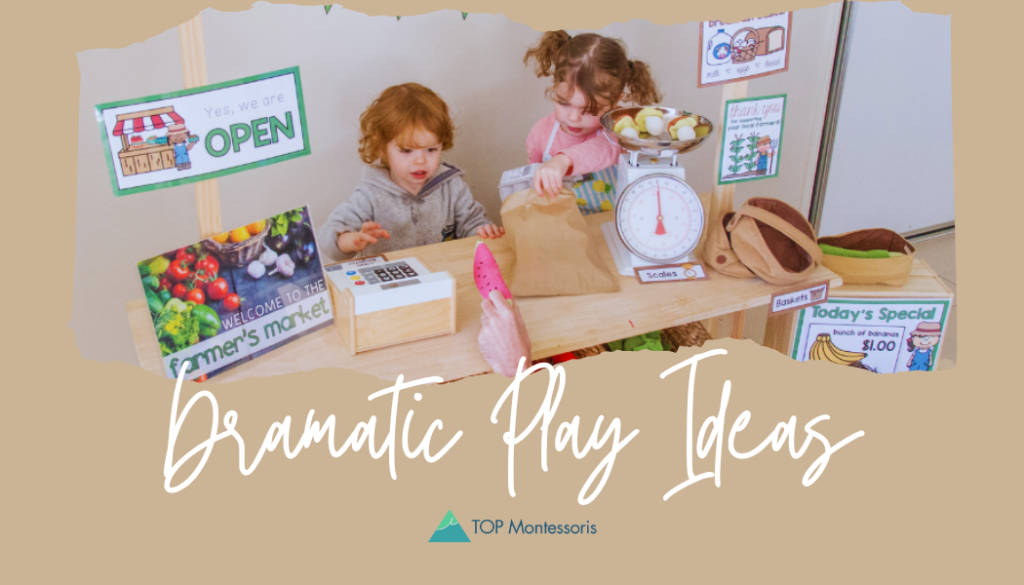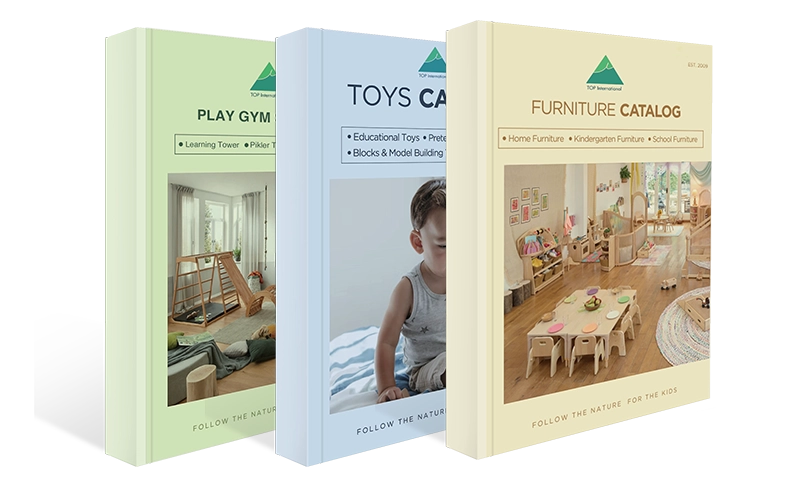Have your preschoolers outgrown simple toys and started acting out scenes from home, school, or even their favorite stories? Are you noticing how much they love pretending to cook, care for babies, or be superheroes, but your classroom doesn’t have the right dramatic play ideas or setup to support their growing imagination?
Dramatic play is more than just fun—it’s a vital part of early childhood education. The right dramatic play ideas for preschool and toddlers nurture imagination, build communication skills, foster empathy, and support physical and cognitive development. From roleplay corners to themed dramatic play centers, there are endless ways to spark curiosity and joyful learning through intentional, well-designed dramatic play.
Let’s dive into what dramatic play is, how it benefits children, and explore over 70 practical dramatic play ideas for preschoolers and toddlers that you can implement right away.
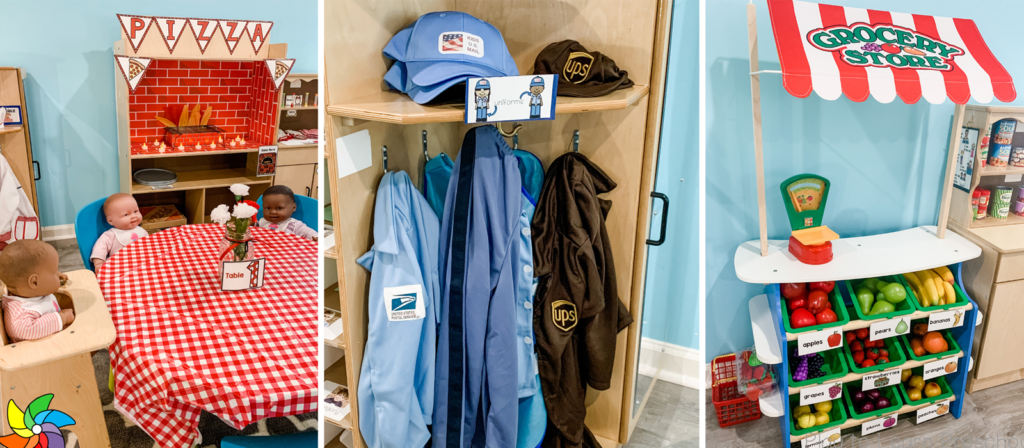
What is Dramatic Play?
Dramatic play is when children use imagination to act out real or pretend situations. It’s more than play—it’s how young minds explore the world, process experiences, and express ideas. Children might pretend to cook, visit the doctor, build a house, or become a superhero. These simple scenarios are powerful tools for learning.
Through dramatic play, children practice language, problem-solving, and cooperation. Whether it’s a fantasy story or everyday life roleplay, they’re building social and emotional skills without even realizing it.
Well-designed dramatic play ideas turn classrooms into creative learning spaces. With thoughtful themes—like kitchens, shops, or rescue stations—educators can guide development through play. No matter the age, the right environment and materials make dramatic play meaningful, playful, and educational.
Types of Dramatic Play
Dramatic play comes in many forms, each unlocking different areas of development. Understanding these categories helps educators choose the right dramatic play ideas for various age groups, from toddlers to preschoolers.
9 Common Types of Dramatic Play:
- Domestic or Household Mimicry: Pretending to cook, clean, or take care of babies. These familiar scenes are ideal dramatic play ideas for toddlers, helping them feel secure while practicing everyday routines.
- Fantasy or Make-Believe: Superheroes, wizards, and magical creatures come to life. These dramatic play ideas for preschool promote imagination and emotional expression.
- Job Roleplay: Doctor, teacher, firefighter—children explore adult roles and responsibilities, building language and empathy.
- Animal Play: Roaring like lions or hopping like frogs, animal play blends creativity with movement and curiosity about nature.
- Construction Play: Building with blocks or using pretend tools helps children develop planning, teamwork, and problem-solving.
- Transportation Play: Pilots, bus drivers, and train conductors in action. These dramatic play ideas teach navigation, direction, and vehicle awareness.
- Acts of Heroism: Children become brave helpers—firefighters, police officers, or superheroes—exploring courage, safety, and fairness.
- Media Reenactment: Kids mimic stories or shows they love. Great for storytelling and memory-building, especially in group settings.
- Socio-Dramatic Play: Group pretend play, like “restaurant” or “birthday party,” builds social skills, cooperation, and leadership.
The Benefits of Dramatic Play
Dramatic play isn’t just a form of entertainment—it’s a vital part of early childhood development. When children pretend to be someone else or act out scenarios, they’re building critical life skills that support their growth across multiple developmental areas.
Lenguaje y comunicación
When children engage in pretend scenarios, they naturally use more language. Whether they’re taking a customer’s order in a pretend café or explaining a diagnosis in a roleplay doctor’s office, they’re practicing vocabulary, sentence structure, and storytelling. These dramatic play ideas support language development in ways that are engaging and age-appropriate.
Desarrollo social y emocional
Through dramatic play, children learn to take turns, negotiate roles, and resolve conflicts. They explore emotions—comforting a crying baby doll, expressing frustration as a “customer,” or feeling pride as a “builder.” These moments help develop empathy, cooperation, and emotional awareness.
Crecimiento cognitivo
Pretend play is full of problem-solving. What should the restaurant serve today? How do you build a stable bridge for toy cars? These scenarios challenge children’s memory, planning, and flexible thinking. Many dramatic play ideas for preschool also integrate early math and literacy—writing menus, counting play money, or reading labels.
Creatividad e imaginación
Whether they’re flying a spaceship or throwing a royal tea party, children in dramatic play create something from nothing. Open-ended materials allow for endless reinterpretation. This type of play supports divergent thinking—a key component of creativity.
Desarrollo físico
Even fine and gross habilidades motoras are involved. Think of buttoning dress-up clothes, setting a play table, or pushing a pretend shopping cart. Dramatic play keeps bodies active and minds engaged.
In summary, thoughtful dramatic play ideas do more than entertain—they nurture the whole child. That’s why creating intentional dramatic play areas isn’t just a classroom “extra,” it’s a foundation for well-rounded growth.
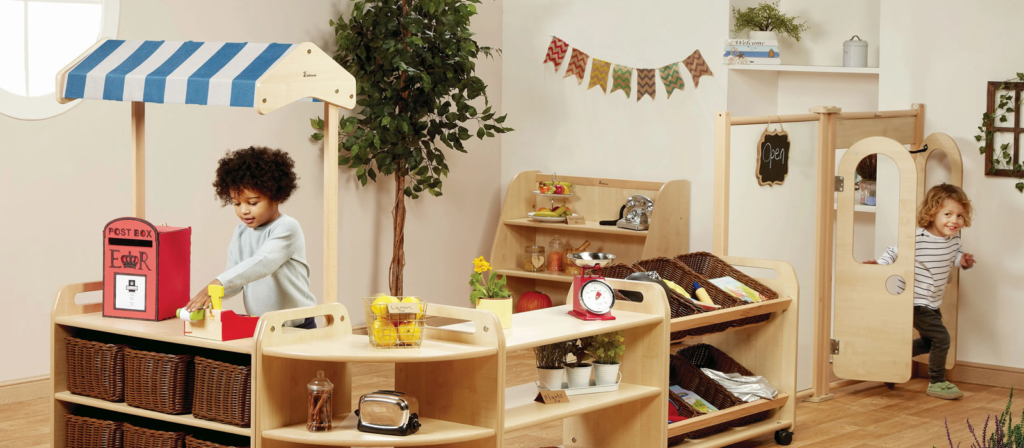
Furniture for Dramatic Play Areas
Creating an immersive, dramatic play environment starts with the right furniture. It’s not only about giving children props to pretend with—it’s about building a physical setting that supports roleplay, encourages independence, and promotes sustained imaginative engagement. The following types of furniture help educators set up effective, flexible dramatic play areas.
Child-sized tables and chairs are essential for setting up believable scenes. Whether children are acting out a classroom, a restaurant, or an office, miniature furniture makes the experience feel real. These pieces allow for natural eye-level interactions and encourage collaborative storytelling. For example, in a classroom dramatic play setup, children can sit in groups, take attendance, or “teach” a lesson using real books or whiteboards.
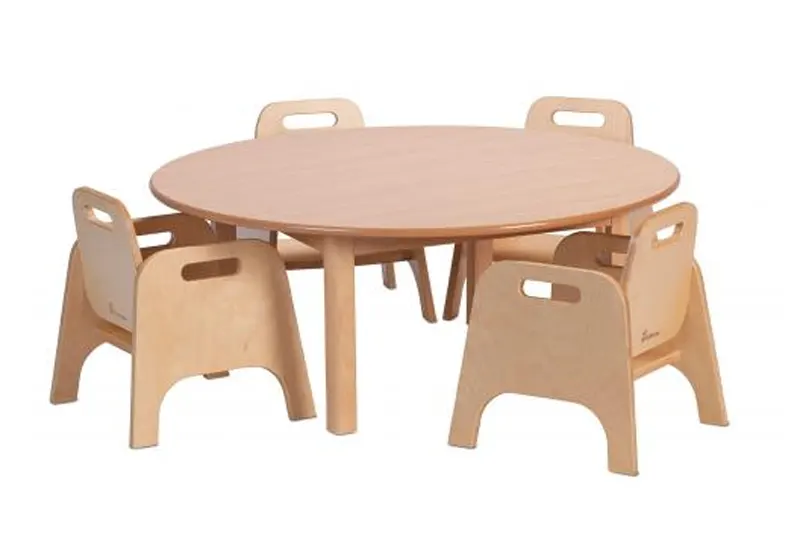
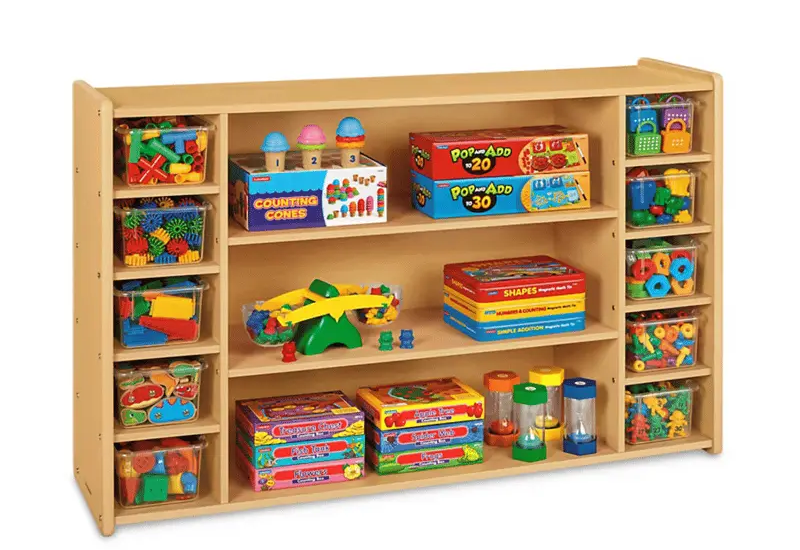
Open shelves and labeled storage bins help maintain order and empower children to manage their play materials. By making costumes, props, and tools easily accessible, storage units support independence and role transitions. A well-organized shelf system can enable quick theme switches—from a post office setup to a dramatic play flower shop or a veterinary clinic, keeping the space dynamic and engaging.
Pretend kitchens are one of the most beloved dramatic play setups. Children naturally gravitate to cooking and food service themes, and with toy appliances like stoves, sinks, and refrigerators, they can replicate what they see at home. These setups are perfect for dramatic play kitchen ideas, where children can roleplay chefs, customers, or parents preparing meals. It also integrates early math, language, and sequencing as they follow recipes or take orders.
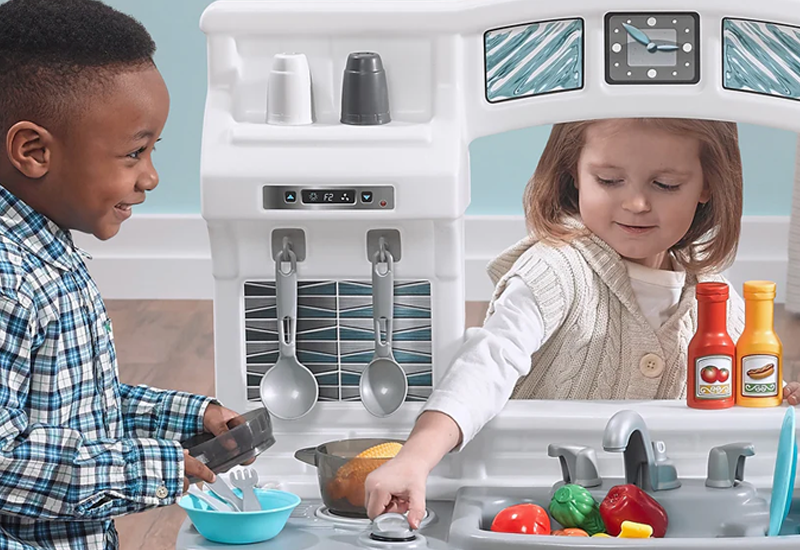

A costume rack filled with thematic outfits allows children to explore identity and character. Lab coats, firefighter jackets, capes, and seasonal costumes make it easy for children to step into new roles. These corners can support themed play such as a fire station, a doctor’s office, or even Christmas dramatic play ideas, where kids dress up as Santa Claus, elves, or reindeer. Add a mirror to encourage self-awareness and self-expression.
Tents, fabric canopies, or wooden playhouses serve as transformable zones that anchor the play theme. A tent might become a hospital, a bakery, or a rocket ship, depending on the week’s focus. These multi-use spaces are essential for dramatic play center ideas for preschool, as they provide a defined, immersive area where children feel safe to extend their stories.
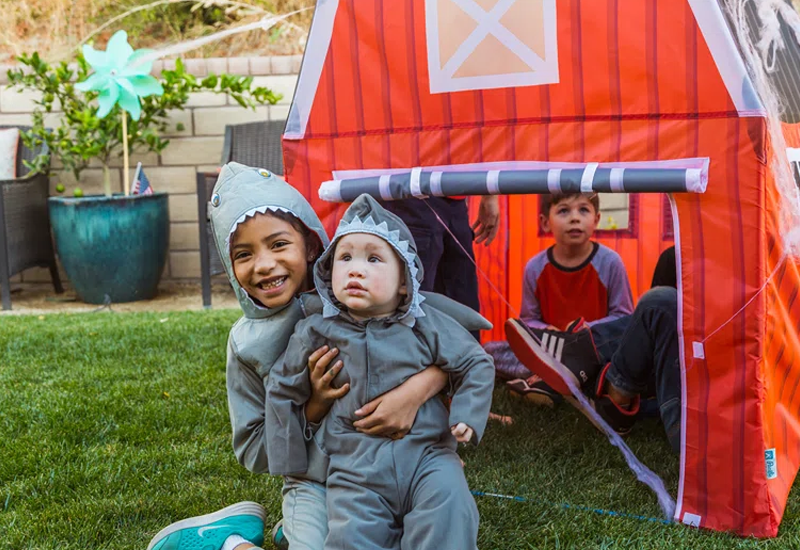
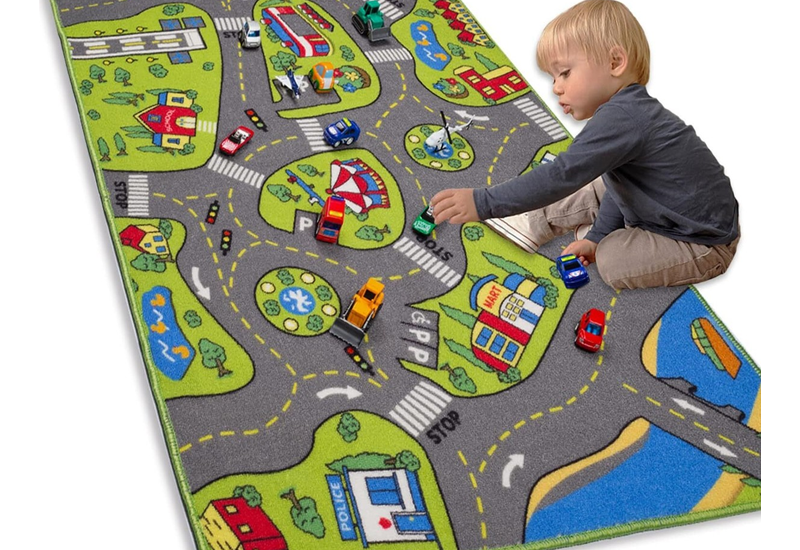
For transportation- or construction-themed dramatic play, toy cars, road mats, and tools help children interact with the world in motion. These props work well both indoors and outdoors, making them great additions to outdoor dramatic play ideas like a pretend fire station or delivery truck scene. Adding signs, traffic lights, or barriers can also bring in elements of environmental print and safety learning.
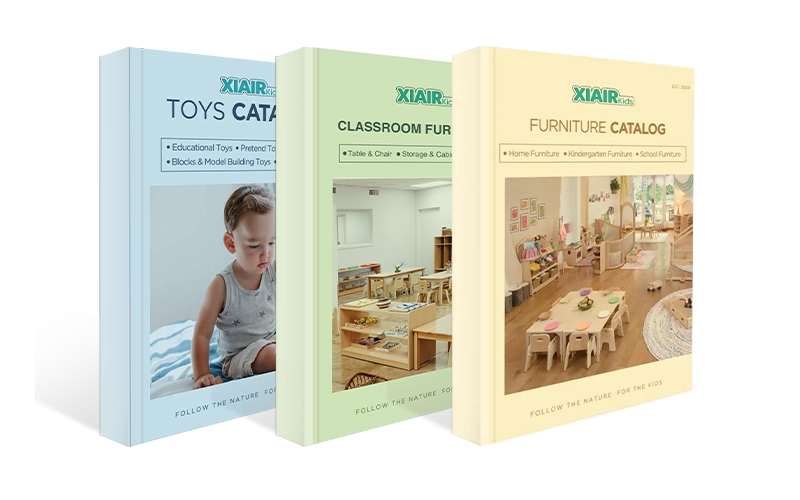
Receive a free catalog and custom layout to help you design your ideal classroom easily.
Dramatic Play Ideas for Preschool
Dramatic play comes alive when supported by imaginative themes that reflect real life, fantasy, and seasonal experiences. Below are over 70 creative, practical, and engaging dramatic play ideas for preschool, organized by theme. These ideas can transform your learning space and spark lasting engagement among children.
Restaurant Dramatic Play Ideas
Pretending to run a restaurant helps children build communication and cooperation skills. These preschool dramatic play ideas support counting, turn-taking, and role-switching as kids serve food, take orders, and play chef or customer.
- Pizza Restaurant: Children love pretending to cook, serve, and dine. A restaurant setup builds communication, math, and sequencing skills.
Materials Needed: mini oven, order pads, aprons, felt pizza toppings, plates, play money, toy menu cards, chef hats, small table and chairs. - Drive-Thru Fast Food: Set up windows, toy cars, and menus. Great for language and direction-following practice. Children enjoy role-switching between driver, cashier, and cook.
Materials Needed: cardboard drive-thru window, toy cars or steering wheels, fast food play sets, menus, order slips, play headset, toy register, trays - Sushi Bar Play Center: Incorporate multicultural elements and fine motor tasks like rolling “rice” and cutting play food. It also encourages respect for global cuisine.
Materials Needed: sushi pretend food (felt rolls), chopsticks, play trays, rolling mats, chef hats, apron, Japanese menu cards, and placemats. - Family Dinner Restaurant: Connect to home routines. Encourage children to act as hosts, servers, and guests. It’s ideal for building empathy and social communication.
Materials Needed: play food (meat, vegetables), plates, cutlery, napkins, tablecloth, menu cards, family-themed costumes, table and chairs.
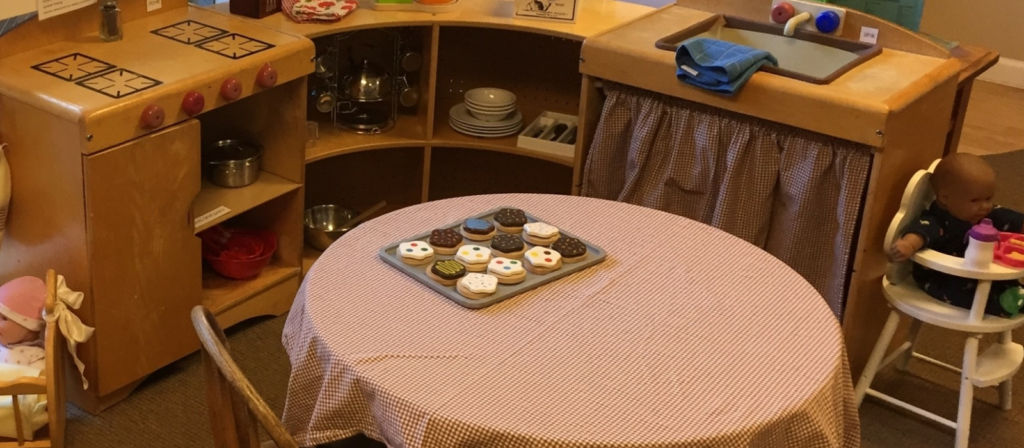
Dramatic Play Dessert Shop
Colorful and sweet, dessert shop dramatic play ideas spark creativity. Children sort by color or size, decorate pretend cupcakes, and practice sharing and conversation while running their own “treat counter.”
- Ice Cream Parlor: Use pom-poms or cotton balls as scoops. Practice patterns and counting while serving. This idea supports sorting by size, color, or “flavor.”
Materials Needed: pom-poms or cotton balls, play cones, ice cream scoopers, play toppings, toy bowls, aprons, order cards, cash register. - Cupcake Café: Set up a bakery counter with trays, frosting tools, and birthday candles. Great for pretend celebrations and recognizing special occasions.
Materials Needed: cupcake trays, felt cupcakes, piping bags, toy candles, aprons, display case, order slips, toy oven. - Donut Shop: Create a pretend fryer and display case. Use paper donuts to teach sorting and design. Kids can also “sell” and “buy” for simple money play.
Materials Needed: paper donuts, pretend fryer, tongs, trays, display shelf, play money, menu cards, napkins.
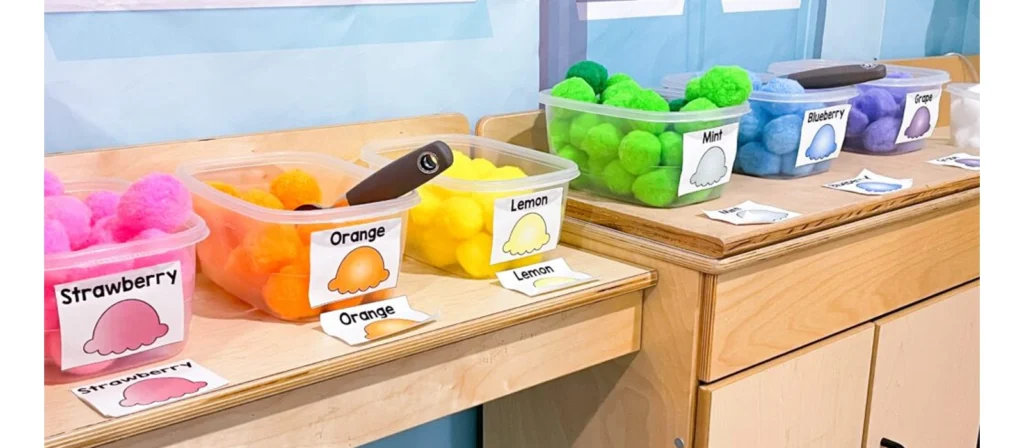
Bakery Dramatic Play Center Idea
Bakeries invite early math and sequencing as children mix, “bake,” and sell pretend treats. These setups foster motor skills and roleplay, making them perfect dramatic play ideas for preschool classrooms.
- Bread & Muffin Baking Station: Children can “knead dough,” stir batter, and set timers. This simulates kitchen routines while developing motor planning.
Materials Needed: play dough, toy mixing bowls, measuring cups, muffin trays, timers, recipe cards, rolling pins, aprons. - Pretend Oven with Recipes: Display simple baking recipes with pictures. The following steps build sequencing and early reading skills.
Materials Needed: toy oven, printed picture recipes, mixing spoons, measuring scoops, trays, and play food ingredients. - Pretend Cake Decorating Table: Kids decorate cakes using pretend icing and toppings. Encourages sensory play, design exploration, and storytelling.
Materials Needed: foam cakes or felt cake shapes, plastic frosting tools, pretend sprinkles, plates, birthday cards, chef hats.
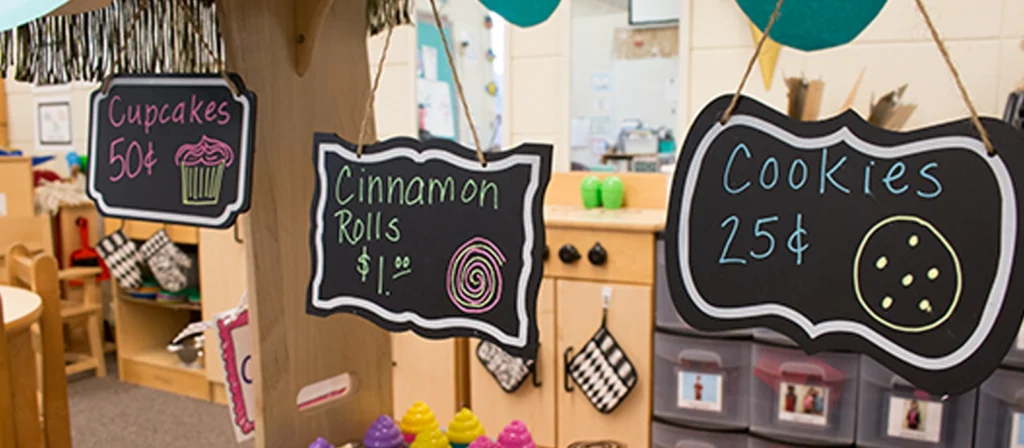
Dramatic Play Drink Shops
From juice bars to coffee counters, drink-themed dramatic play ideas help children develop sequencing, fine motor control, and polite conversation. Great for encouraging social language and turn-taking.
- Juice Bar: Pretend fruits, cups, and blenders. Kids take custom orders and blend “drinks.” It’s also a fun way to reinforce fruit names and colors.
Materials Needed: toy blender, plastic cups, felt fruits, order cards, play straws, aprons, menus, toy ice cubes. - Milk Tea Stand: Cultural enrichment with bubble tea props and cups. Children enjoy using tongs or scoops to add “tapioca” balls, supporting fine motor skills.
Materials Needed: transparent cups, small beads (for pearls), tongs, straws, felt tea bags, drink stickers, and serving trays. - Coffee Shop: Kids create menus, pour coffee (colored water), and serve customers at the counter.
Materials Needed: play coffee cups, toy espresso machine, menus, cash register, aprons, pastries, notepads for orders.
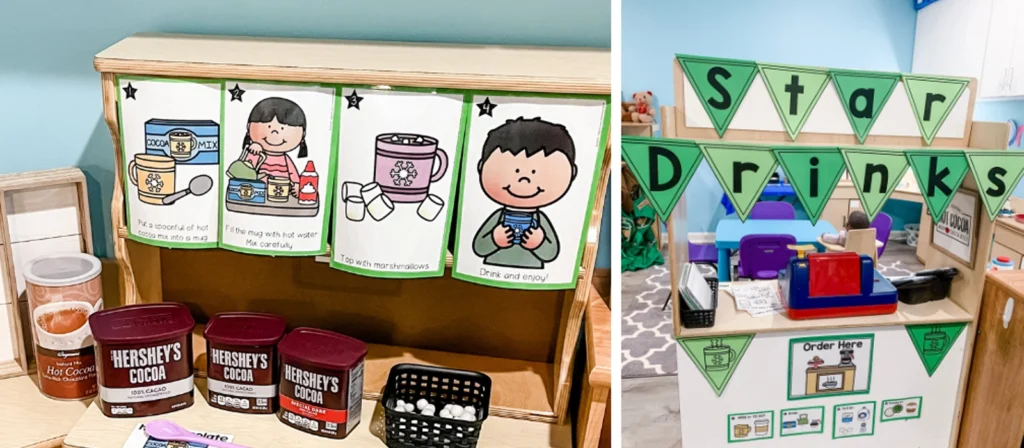
Community Helper Dramatic Play Ideas
Children love acting as firefighters, doctors, or mail carriers. These dramatic play ideas build empathy and help preschoolers understand community roles through storytelling and cooperative play.
- Fire Station: Set up hoses, walkie-talkies, and fire hats. Practice emergency drills. This play also introduces safety vocabulary and teamwork.
Materials Needed: firefighter hats, hoses (foam or rope), walkie-talkies, fire jackets, ladders (toy or cardboard), fire alarm bell, firefighter badges. - Police Station: Create ID cards, a “lost and found” box, and walkie-talkies. Children learn about rules, fairness, and responsibility.
Materials Needed: police hats, toy badges, walkie-talkies, ID cards, “wanted” posters, toy handcuffs, pretend desk setup. - Post Office: One of the best dramatic play ideas for preschool—use envelopes, stamps, and sorting bins.
Materials Needed: envelopes, stamps (stickers or stamps), mailbags, sorting bins, boxes, address labels, and a pretend mailbox.

Store Dramatic Play Ideas
Pretend shopping is full of learning—children explore counting, sorting, and using pretend money. Grocery store or flower shop dramatic play ideas support vocabulary and real-world understanding.
- Dramatic Play Grocery Store Ideas: Use shelves, carts, baskets, and toy food. Children act as cashiers and shoppers. This supports counting, sorting, and using polite customer language.
Materials Needed: play food, shopping baskets, toy shelves, cash register, receipt slips, price tags, shopping list cards. - Flower Shop: A classic, dramatic play flower shop idea with vases, ribbons, and wrapping stations. Great for sensory and seasonal themes. Children can also learn about plant types and color matching.
Materials Needed: artificial flowers, ribbons, vases, tissue paper, scissors (plastic), flower wrapping station, order slips. - Toy Store: Children categorize toys, “restock” shelves, and handle pretend money.
Materials Needed: assorted toys, shelves, price tags, shopping bags, toy scanner, cash register, store signs.
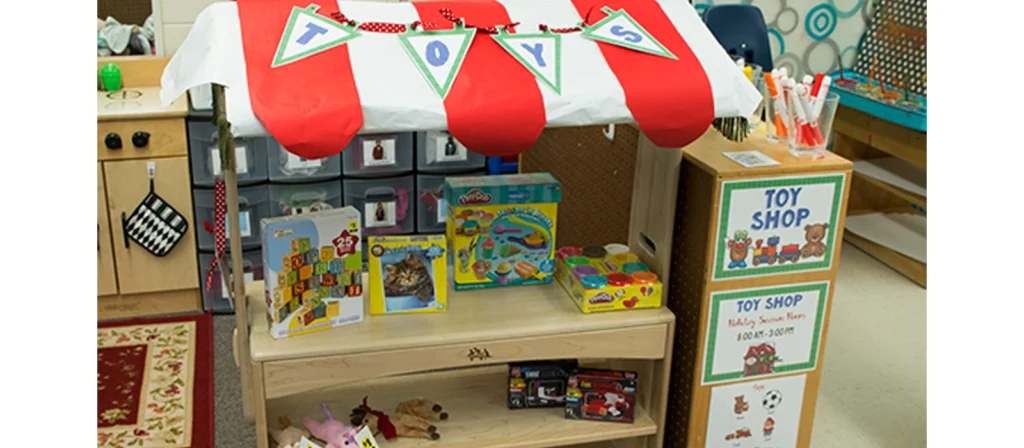
Sport Themed Dramatic Play
Sports dramatic play themes encourage gross motor movement and teamwork. Kids love taking turns as players, coaches, or referees while learning rules and developing coordination.
- Soccer Stadium: Kids act as players, referees, and fans. Mark goals and set rules. Promotes physical coordination and group strategy.
Materials Needed: foam soccer ball, team jerseys or pinnies, cones for goals, whistle, scoreboard (paper), tickets, fan signs. - Olympics Roleplay: Add podiums and medals. Explore sports from different countries. Children also learn sportsmanship and cultural diversity.
Materials Needed: medals, podium, flags, sports props (baton, balls), timers, announcer cards, and country signs. - Basketball Booth: Use foam balls and a mini hoop for indoor dramatic play. Great for aim, strength, and one-to-one correspondence counting.
Ideal for indoor active play. Children shoot hoops, count scores, and cheer for friends. - Materials Needed: foam basketballs, mini hoop, jerseys, scoreboard, whistle, tickets, cones.
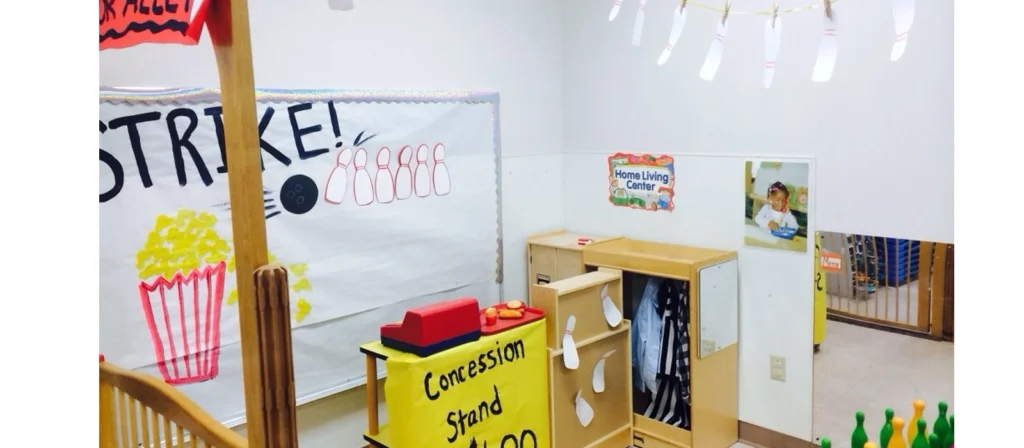
Dramatic Play Repair Shops
Whether it’s fixing bikes or washing toy cars, repair shop dramatic play ideas combine STEM concepts with hands-on tools, promoting problem-solving and persistence.
- Car Wash Dramatic Play Ideas: Use sponges, toy cars, and spray bottles. Add signs and price lists. Kids love the sensory experience and learn about sequencing (“wash, rinse, dry”).
Materials Needed: toy cars, sponges, towels, water spray bottles, buckets, soap signs, service station props. - Bicycle Repair Station: Provide pretend wrenches, pumps, and helmets. This play encourages cooperation and builds knowledge of safety tools.
Materials Needed: toy bicycles or wheels, plastic tools (wrenches, screwdrivers), air pump, workbench or table, helmets, safety signs, clipboards. - Appliance Repair Center: Reuse old keyboards or phones to practice fixing and assembly. Supports hand-eye coordination and creative reuse.
Materials Needed: broken electronics (safe items only), toy toolsets, parts trays, pretend invoices, screwdrivers, magnifying glasses, gloves.

Art-Related Dramatic Play Centers
Art studio themes inspire storytelling, roleplay, and design. Children explore emotions, patterns, and expression—key parts of creative dramatic play in early learning.
- Gallery & Art Museum: Children roleplay as artists, curators, and visitors. Add clipboards for note-taking. Encourages descriptive language and appreciation of visual art.
Materials Needed: easels, blank canvases, paintbrushes, smocks, art frames, museum labels, gallery signs, clipboards. - Face Painting Studio: Offers face charts and brushes (no paint needed). Supports design thinking and role negotiation.
Materials Needed: face chart printouts, brushes, mirrors, order forms, headbands or capes, pretend face paint palettes. - Photography Shop: Kids pose, take pretend pictures, and make “photo albums.” Reinforces memory, sequencing, and emotional expression.
Materials Needed: toy cameras, backdrops, photo props (hats, glasses), photo albums or frames, customer order forms, and lights.
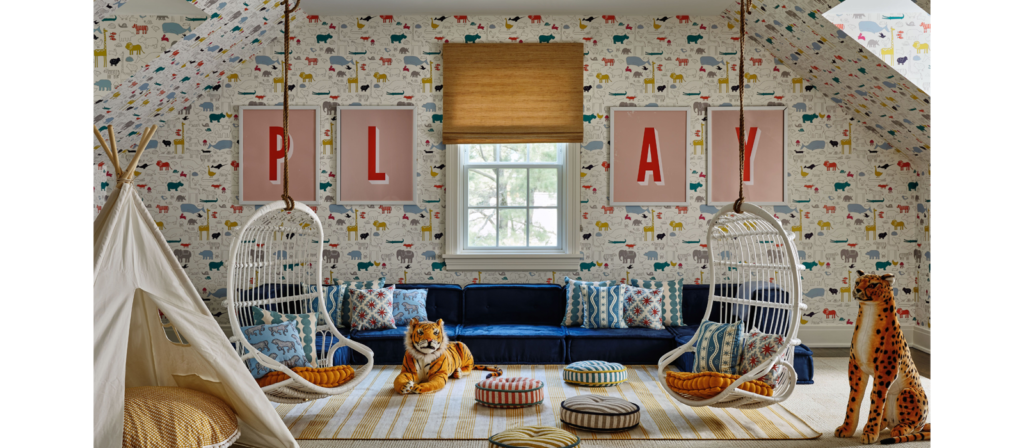
Construction & Building Dramatic Play Themes
Building sites teach planning, teamwork, and physical coordination. These dramatic play ideas let kids use tools and blocks to role-play as architects and builders.
- Construction Site: Use plastic tools, safety vests, and blocks. Children can “build” walls or roads and operate toy machines. Teaches roles like architect, builder, and foreman.
Materials Needed: blocks or foam bricks, safety vests, toy tools, helmets, construction signs, blueprints, measuring tape. - Recycling Center: Teach environmental care with labeled bins, sorting games, and pretend garbage trucks. Builds classification and ecological responsibility.
Materials Needed: labeled recycling bins, pretend trash (clean containers, boxes), tongs, sorting charts, gloves, and environmental signs. - Road Work Station: Create road signs and cones. Kids pretend to fix potholes, paint lines, and manage traffic. Create road signs and cones. Kids pretend to fix potholes, paint lines, and manage traffic. Introduces early civics and community service.Road Work Station: Create road signs and cones. Kids pretend to fix potholes, paint lines, and manage traffic.
Materials Needed: cones, vests, toy signs (stop, slow), paintbrushes, cardboard roads, toy vehicles, role badges.
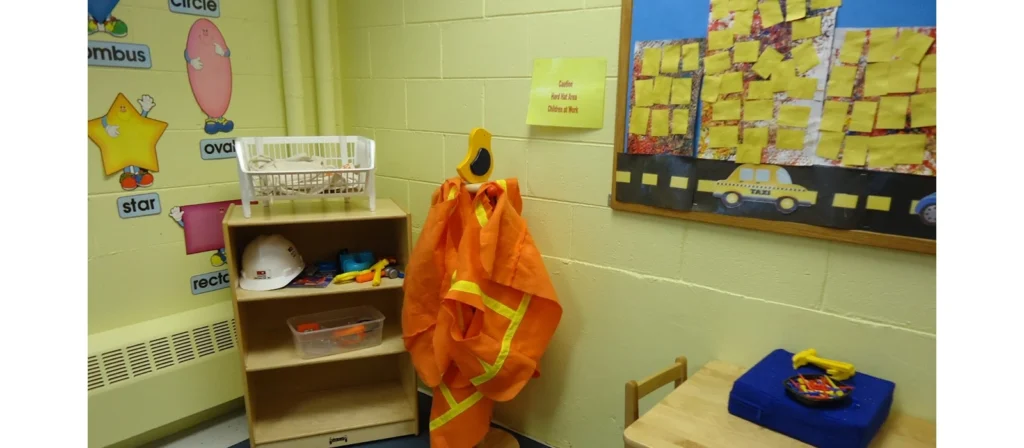
Science Dramatic Play Ideas
Dinosaur digs, insect labs, and space missions bring science to life. These dramatic play ideas for preschool support observation, vocabulary, and early STEM exploration.
- Dinosaur Excavation Site: Children dig for fossils, identify species, and use brushes and magnifiers. Enhances fine motor skills and scientific curiosity.
Materials Needed: sandbox or sensory bin, toy bones or fossils, brushes, magnifying glasses, excavation maps, safety goggles, fossil ID charts. - Insect Lab: Observe pretend bugs with tweezers and magnifying glasses. Great for springtime play. Supports life science vocabulary and observation.
Materials Needed: plastic insects, magnifiers, specimen jars, observation clipboards, tweezers, lab coats, posters of insect life cycles. - Space Station: Helmets, control panels, and stars turn your classroom into a galaxy of imagination. Ideal for dramatic space-themed storytelling and problem-solving.
Materials Needed: space helmets (DIY or plastic), control panels, walkie-talkies, stars and planets decor, mission logs, space suits. - Butterfly Garden: Act out the life cycle of a butterfly. Include wings, flowers, and leaf props. Integrates science with expressive movement.
Materials Needed: butterfly wings, flower props, green fabric (leaves), life cycle chart, bug jars, netting, role badges.
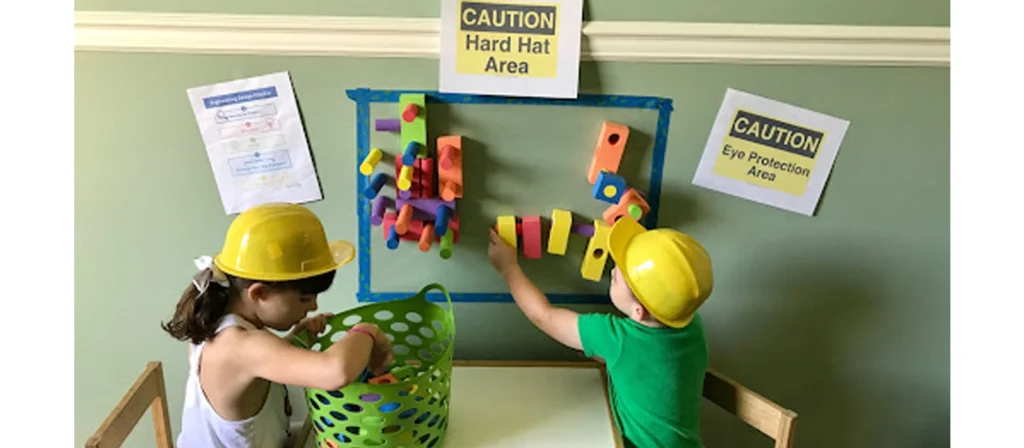
Animal Dramatic Play Centers
Zoo keeper and vet clinic themes build empathy and curiosity about nature. These dramatic play ideas are ideal for movement, roleplay, and animal care routines.
- Zoo Keeper Roleplay: Stuffed animals, enclosures, and feeding stations let kids act as animal caretakers.
Materials Needed: stuffed animals, enclosures (boxes or bins), feeding bowls, pretend food, zookeeper hats, grooming brushes, name tags. - Veterinary Clinic: Children diagnose, treat, and care for sick plush animals in the role of veterinarians.
Materials Needed: doctor kits, bandages, stethoscopes, clipboards, plush animals, x-ray sheets, appointment cards, and an exam table. - Pet Shop: Set up cages, collars, food dishes, and “adoption forms” to encourage responsibility and compassion.
Materials Needed: cages or bins, collars, leashes, pet food containers, price tags, cash register, shopping bags.

Fashion & Beauty Dramatic Play
These play centers promote self-expression, creativity, and social interaction.
- Hair Salon: Use combs, brushes, mirrors, and “appointment” sheets. Kids roleplay as stylists and customers.
Materials Needed: combs, brushes, mirrors, toy hairdryers, chairs, pretend shampoo bottles, appointment books, and towels. - Dress Boutique: Kids explore fashion by sorting clothes and helping each other “shop.” This dramatic play idea boosts creativity and vocabulary.
Materials Needed: clothing racks, hangers, dresses and hats, mirrors, price tags, play money, shopping baskets. - Fashion Runway: Children walk a “runway” in costumes, describing their outfits and cheering on peers. Builds confidence and presentation skills.
Materials Needed: music player, costumes, lights or spotlight, runway mat, audience chairs, scorecards, microphones.
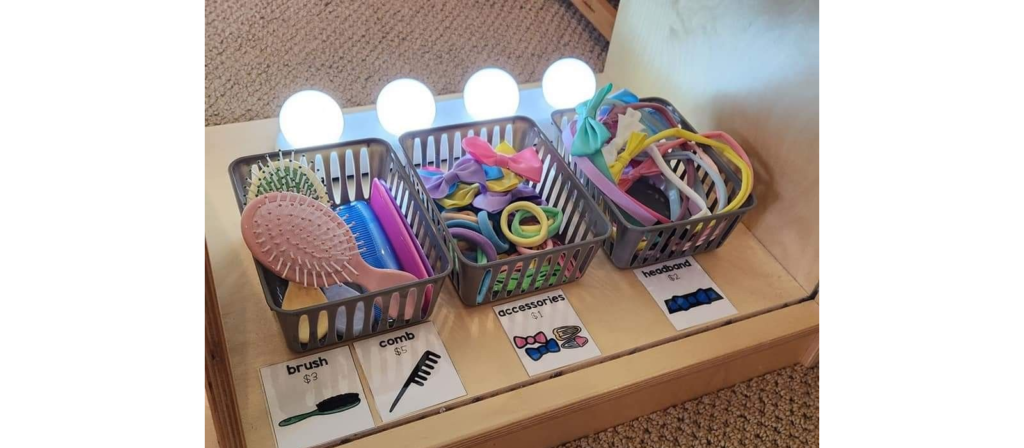
Transportation Dramatic Play Ideas
Ideal for movement-based learning and exploration of real-world systems.
- Airport: Include tickets, suitcases, security lines, and a cockpit area. Children can be pilots, flight attendants, and travelers, promoting sequencing and travel-related vocabulary.
Materials Needed: suitcases, tickets, boarding passes, cockpit controls, security station props, airline uniforms, seating area. - Train Station: Arrange chairs into train cars. Add a conductor role and announce destinations. Encourages cooperation and pattern recognition (“next stop”).
Materials Needed: cardboard tickets, conductor hats, signs for stops, toy suitcase, punchers, seating labels, pretend microphone. - Bus Depot: Set up route maps, stop signs, and a driver’s seat. Great for transition-based learning.
Materials Needed: steering wheels, stop signs, route charts, student passes, driver vests, seating numbers.
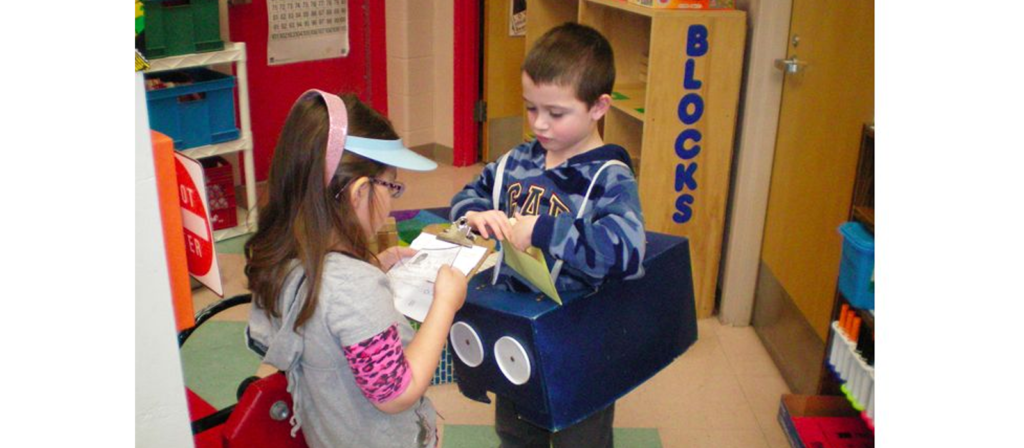
Tourist Dramatic Play Center
Introduce geography, culture, and communication through travel-themed roleplay.
- Travel Agency: Use maps, brochures, and booking forms to explore the world. Promotes decision-making and early map-reading.
Materials Needed: world maps, brochures, fake passports, booking forms, desk props, country flags. - Hotel Reception: Offer check-in desks, keys, and pretend room service menus. Children practice customer service dialogue and hospitality manners.
Materials Needed: front desk sign, pretend keys, bell, menu cards, reservation forms, and suitcases. - Beach Getaway: Towels, sunglasses, beach balls, and sunscreen props create a fun vacation setting.
Materials Needed: beach towels, umbrellas, beach balls, sunglasses, sunscreen bottles, buckets and shovels.
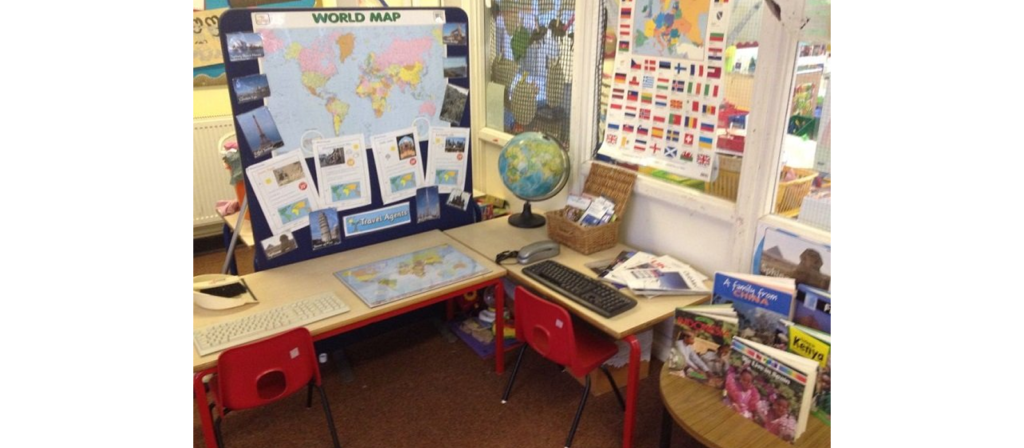
Television Dramatic Play Centers
Let children explore storytelling and performance through media themes.
- News Studio: Microphones, toy cameras, and scripts allow children to “report the news.” Strengthens speaking skills and expressive language.
Materials Needed: toy microphones, cameras, cue cards, desk setup, news scripts, “live” signage. - Cooking Show: Acting out a TV chef’s role blends pretend kitchen play with public speaking. Supports instructional language and sequence learning.
Materials Needed: play kitchen set, recipe cards, aprons, toy utensils, plates, pretend ingredients. - Weather Station: Materials Needed: weather charts, symbols (sun, rain, snow), thermometer props, pointer stick, forecast cards.
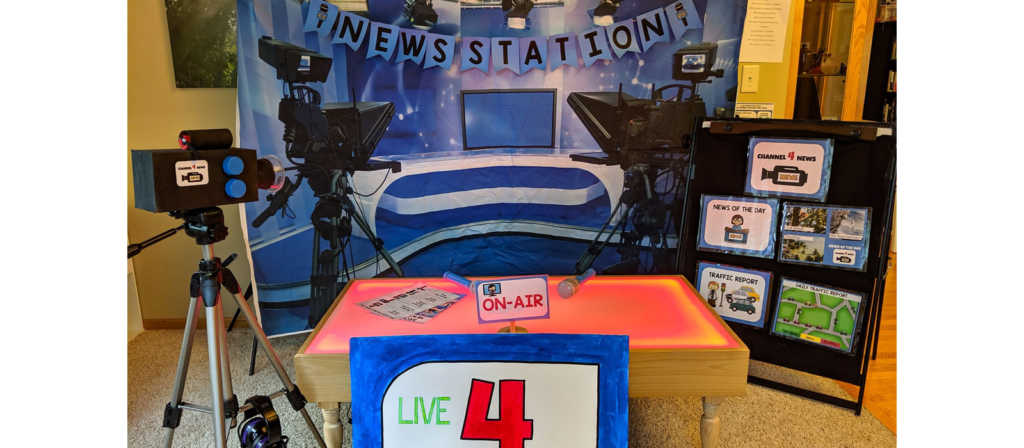
Everyday Dramatic Play Ideas
Sometimes the most relatable themes inspire the deepest play.
- Kitchen: A classic favorite. Children cook, wash dishes, and serve meals. Builds real-life vocabulary and sequencing (“first we cook, then we eat”).
Materials Needed: pots and pans, play food, plates, cups, sink station, toy stove, aprons. - Aula: Kids take on roles like teacher, student, or principal. Supports social rules and communication.
Materials Needed: whiteboard or chalkboard, books, classroom signs, name tags, pointer sticks, stickers, role cards. - Car Wash: Toy cars, soap bottles, and sponges add sensory and movement fun. Encourages group teamwork and pretend business operations.
Materials Needed: toy cars, sponges, spray bottles, towels, signs, price lists, car wash tunnel (cardboard or fabric). - Laundry Center: Try sorting clothes, folding, or packing for a pretend trip. Supports categorization and motor skills.
Materials Needed: baskets, child-sized clothing, clothespins, toy washing machine, laundry detergent bottles, folding table.
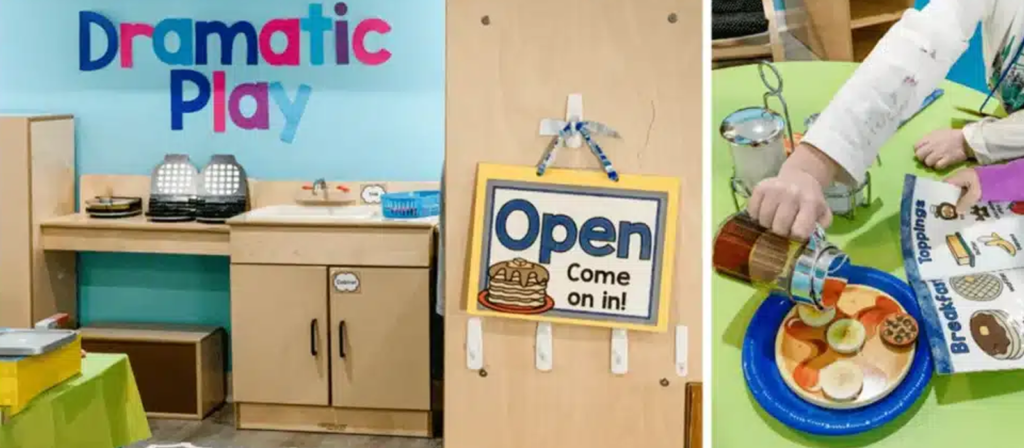
Additional Community Dramatic Play Ideas
Broaden understanding of how people contribute to society.
- Dentist Office: Explore tools, hygiene, and dental care through roleplay. Helps reduce the fear of honest dentist visits.
Materials Needed: toothbrushes, tooth models, mirrors, masks, dental chair (child-sized), appointment cards, gloves. - Bank: Set up ATMs, checkbooks, and pretend money to learn basic math and social exchange.
Materials Needed: play money, checkbooks, calculators, deposit slips, bank counter, fake ATM, cash drawer. - Mayor’s Office: Children take on leadership roles and write community “laws” or solve local problems.
Materials Needed: desk, clipboard, pretend law books, ballots, city map, campaign signs, phone props.
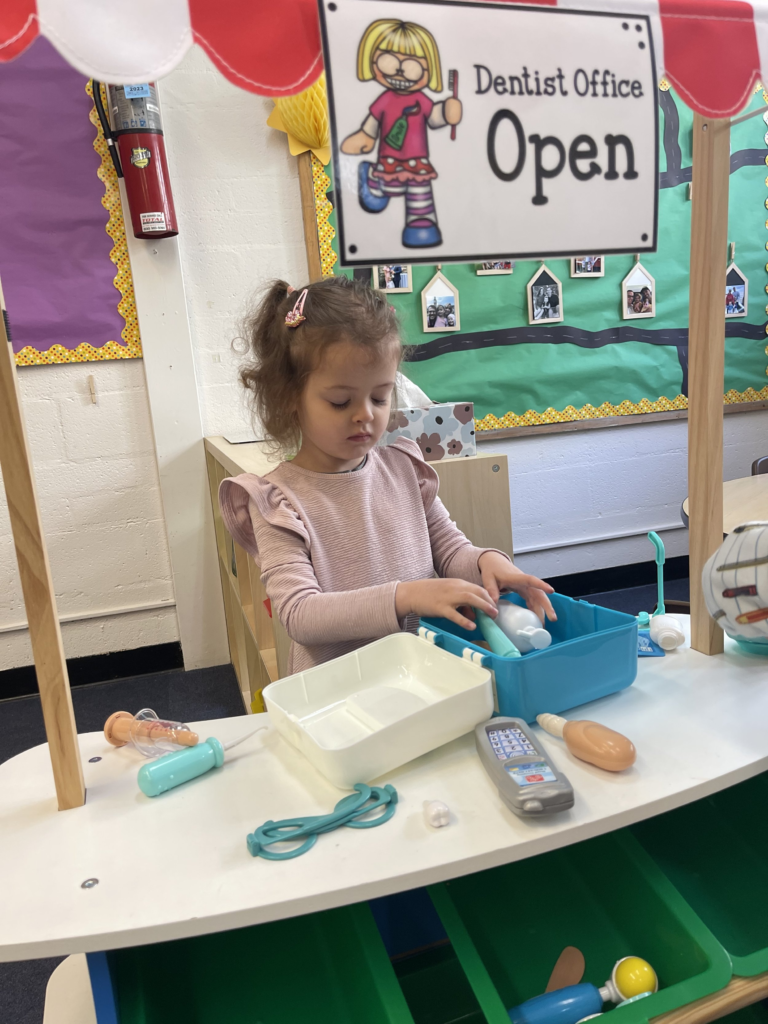
Spring dramatic play ideas
Spring themes connect children with nature, life cycles, and weather through hands-on, imaginative play.
- Rainy Day Weather Station: Set up raincoats, umbrellas, and puddles for splashing. Children learn about weather, clothing choices, and cause and effect.
Materials Needed: child-sized umbrellas, rain boots, raincoats, shallow water trays (or blue fabric), weather charts, pretend clouds. - Seed Shop: Include seed packets, planting pots, and order forms. Kids can “sell” seeds and discuss plant life cycles.
Materials Needed: seed envelopes, small pots, play money, shopping baskets, clipboards, labels, pretend soil. - Bird-Watching Station: Add binoculars, bird charts, and nests. Children pretend to spot and record different birds in spring.
Materials Needed: toy binoculars, bird identification posters, bird puppets, artificial nests, journals, pencils.
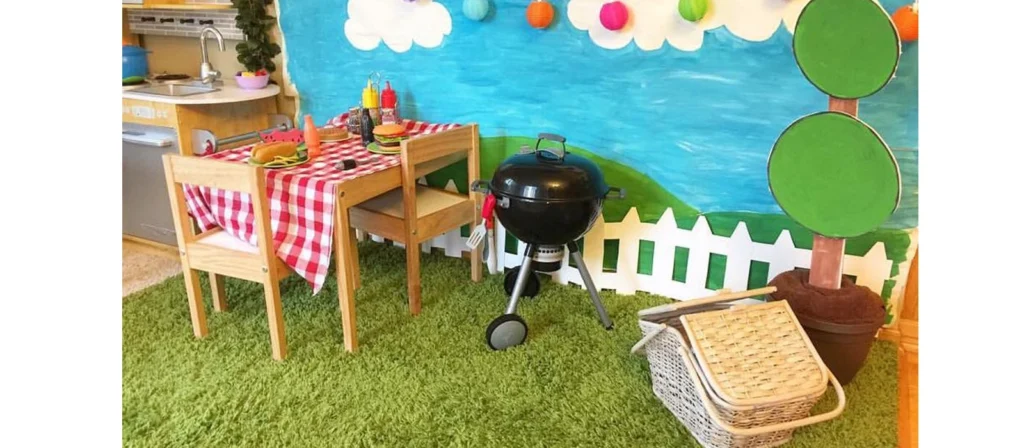
Summer dramatic play ideas
Summer play invites adventure, travel, and outdoor fun, encouraging movement and creativity.
- Outdoor BBQ Stand: Use toy grills, play food, and tongs. Kids host a picnic or BBQ party, practicing hosting and food prep.
Materials Needed: toy grill, plastic burgers and hot dogs, spatulas, tongs, picnic table setup, pretend condiments. - Watermelon Farm: Set up crates, sliced watermelon, and delivery trucks. Helps reinforce colors, textures, and counting.
Materials Needed: toy watermelon slices, wooden crates, play trucks, cash register, farmer aprons. - Road Trip Adventure: Use maps, suitcases, sunglasses, and car props. Children plan destinations, pack bags, and pretend to travel.
Materials Needed: road maps, luggage, steering wheel prop, sunglasses, car seat signs, travel brochures.
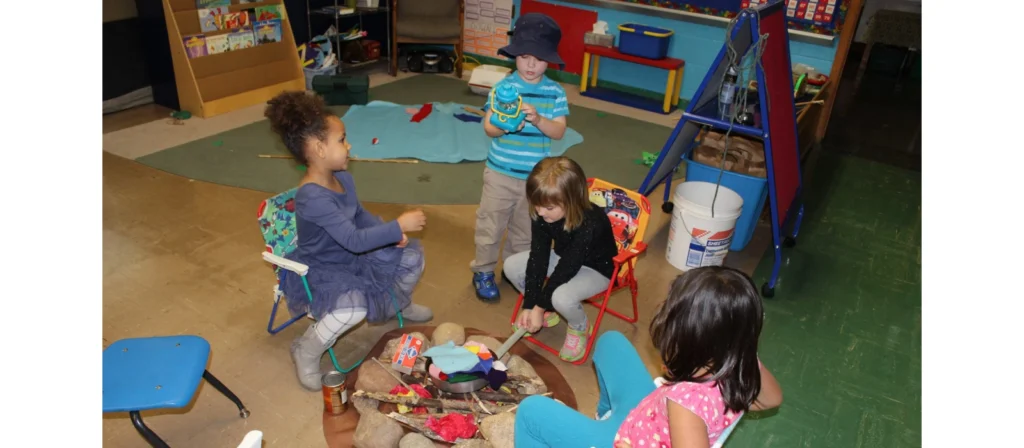
Fall dramatic play ideas
Fall centers around harvest, change, and celebration, offering sensory-rich, seasonal experiences.
- Pumpkin Patch: Provide baskets, weighing scales, and mini pumpkins. Kids pick, sort, and “sell” different types.
Materials Needed: foam pumpkins, market baskets, toy scales, hay bales, signs with prices, cash drawer. - Leaf Collection Center: Offer rakes, leaf bags, and sorting trays. Children collect and categorize pretend leaves by shape or color.
Materials Needed: silk leaves, kid-sized rakes, sorting bins, leaf identification charts, paper bags. - Scarecrow Workshop: Create hats, buttons, and straw props. Kids build their scarecrows and roleplay protecting crops.
Materials Needed: flannel shirts, straw bundles, buttons, felt hats, broomsticks or cardboard bases, markers.
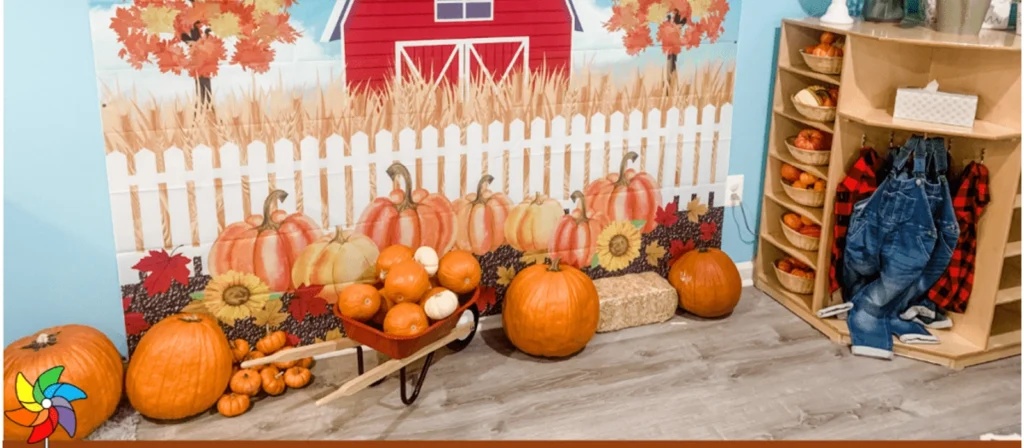
Winter dramatic play ideas
Winter themes explore snow, holidays, and cozy indoor life, inspiring storytelling and cultural awareness.
- Ice Skating Rink: Tape “skates” to shoes and lay down felt or cardboard “ice.” Children sell tickets and perform routines.
Materials Needed: felt sheets for ice, paper skates, tickets, scarves, music player, cones for rink boundaries. - Snowman Building Station: Use white cushions, felt features, and scarves. Kids build snowmen and name their creations.
Materials Needed: white cushions or stacked boxes, buttons, scarves, hats, plastic carrots, gloves. - New Year’s Party Center: Include pretend snacks, party hats, and a countdown clock. Encourage calendar awareness and celebration vocabulary.
Materials Needed: party hats, noisemakers, paper clocks, plastic cups, streamers, pretend snacks.
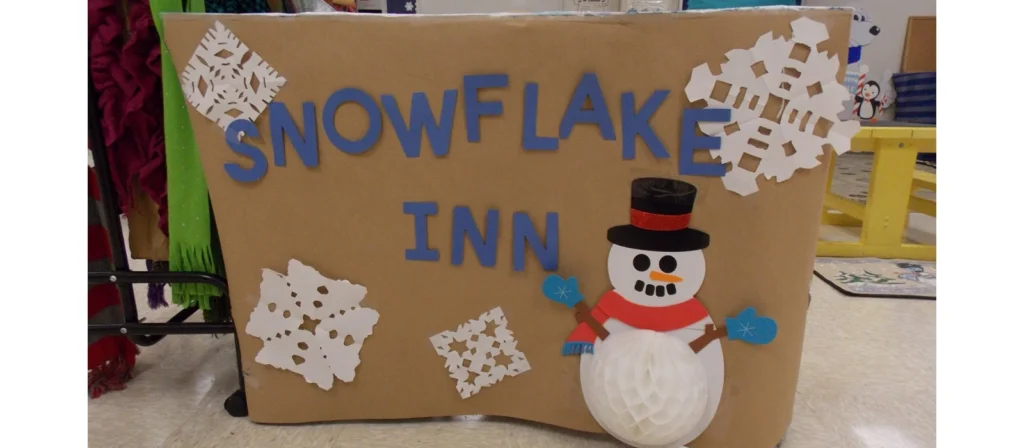
Farm & Camping Themes
Outdoor-focused scenes that encourage nature play and real-life connections.
- Farm: Include barns, animals, produce baskets, and milking stations—great for farm dramatic play ideas.
Materials Needed: plush farm animals, hay bundles, milk jugs, egg cartons, mini baskets, and farm signs. - Camping: Tents, lanterns, faux campfires, and pretend marshmallow roasting support both indoor and outdoor play.
Materials Needed: play tent, sleeping bags, pretend lanterns, felt campfire, marshmallows on sticks, backpacks.

Identity & Personal Themes
Build self-awareness and emotional literacy through personal storytelling.
- All About Me Theme: Children create homes, represent their families, or act out personal routines.
Materials Needed: family puppets or photos, mirrors, small furniture props, pretend baby dolls. - Birthday Party Center: Set up pretend cakes, party hats, and gift exchanges.
Materials Needed: birthday hats, candles, pretend cake, gift boxes, streamers, party plates, invitation cards. - Hospital Birth Center: Children act out welcoming a new baby and family bonding moments.
Materials Needed: baby dolls, bassinets, ID bracelets, swaddling blankets, nurse hats, parent props, birth certificates.
How to Encourage Young Children to Play?
Even the best-designed dramatic play areas won’t engage children unless the environment, materials, and adult support are aligned. Some children jump into pretend play easily, while others may need structure, inspiration, or a little encouragement. The goal is to help every child, especially those in the early years, find joy and confidence through play.
Make the Space Inviting and Easy to Access
A cluttered or confusing environment can turn children away. Organize your dramatic play center clearly with labeled props, child-sized furniture, and themed zones. When implementing new dramatic play ideas, use signs, role cards, or color-coded baskets to guide children without overwhelming them. For toddlers, simplicity is key—offer just a few high-interest props at a time.
Rotate Themes Based on Interests
Keeping the space fresh encourages return visits. Rotate your dramatic play ideas for preschool regularly—one week a bakery, the next a veterinarian clinic. Use children’s current interests as inspiration. If they’re curious about bugs, try an insect dramatic play idea. If they’re excited about food, set up a smoothie shop or pizzeria. Relevance boosts engagement.
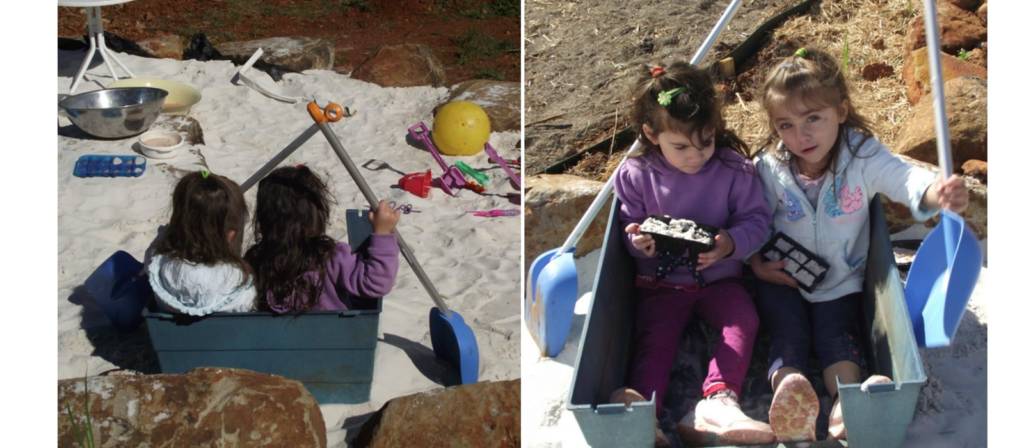
Use Realistic and Open-Ended Props
Children are drawn to materials they recognize from home or daily life. Include real (safe) objects like wooden spoons, old phones, or empty food boxes to support dramatic play ideas for toddlers. Combine these with open-ended materials like fabric, cardboard, or simple costumes so they can shape their narratives.
Model Without Leading
Join in briefly to model how to use props or start a story. For example, “I’d like to order a sandwich, please!” at a pretend café. Step back once a child picks up the idea. Children are more likely to sustain engagement when the play comes from them, not from adult direction.
Pair Children Strategically
Some children need a peer to break the ice. Pair a hesitant child with one who’s confident in pretend play. You can assign simple roles—like “You’re the customer today”—to gradually build social and emotional comfort.
Keep it Open-Ended
Avoid over-planning. The best dramatic play ideas leave room for creativity. Let the grocery store become a flower shop, or the kitchen turn into a science lab. Encourage role swaps and story changes. Flexibility keeps children engaged longer.
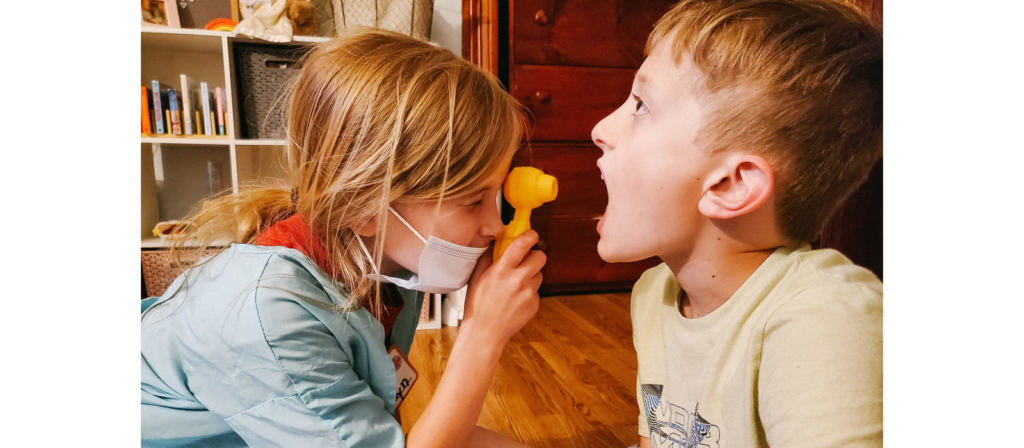
Encourage Language and Storytelling
Ask open-ended questions like “What are you cooking today?” or “Who else works in this shop?” This builds vocabulary and narrative thinking. In dramatic play ideas for preschool, conversation is just as meaningful as the props.
Dramatic play thrives in a well-prepared environment where children feel safe to take risks, follow their curiosity, and tell their stories. With planning and gentle guidance, even the most hesitant child can become fully immersed in imaginative learning.
Why Dramatic Play Helps Children Express Themselves?
Dramatic play is more than fun—it’s a powerful emotional, cognitive, and social outlet. Through imaginative roleplay, children process their experiences, express feelings they may not yet have words for, and build inner resilience. Whether it’s reenacting a trip to the doctor, pretending to be a superhero, or creating their world, dramatic play helps children feel seen, safe, and heard.
A Safe Way to Express Emotions
Many children don’t have the language to explain how they’re feeling. Through dramatic play ideas, they can act out frustration, fear, or excitement using pretend situations. A child might comfort a crying doll, build a “hospital” for sick animals, or pretend to lose something and find it again. These experiences help them understand and release real emotions in symbolic, safe ways.
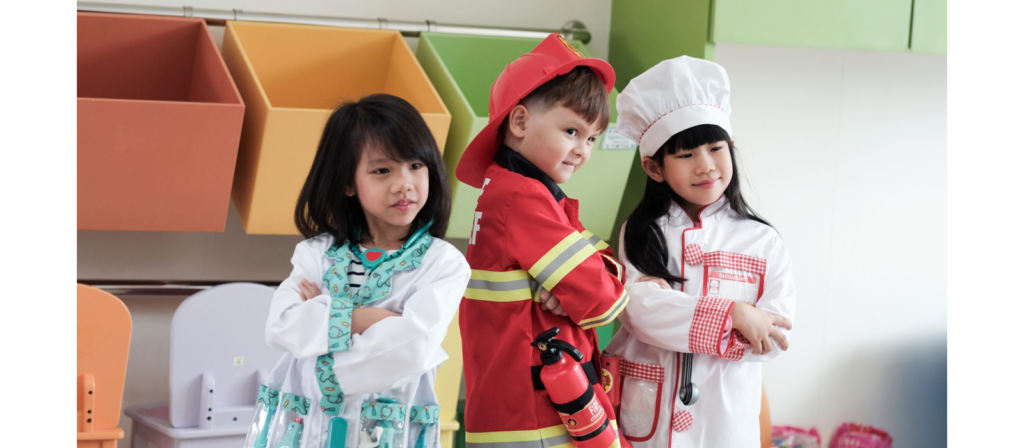
Replaying Real-Life Experiences
Dramatic play lets children replay what they observe in daily life. If a child recently went to the dentist, setting up a dentist’s dramatic play area might help them process that event. If there was conflict at home, they might create a peaceful family dinner at a pretend restaurant. For toddlers, mainly, dramatic play ideas for toddlers often revolve around routines like bedtime, cooking, or cleaning—activities that help them gain emotional security.
Reducing Stress and Building Confidence
Pretend play gives children a sense of control in a world where adults often make the rules. When they take on roles—teacher, firefighter, doctor—they become the ones making decisions. This boosts confidence and gives them a healthy outlet for stress. It also allows children who feel shy or overwhelmed in real life to take on influential roles in a world of their design.
Supporting Mental Health Through Play
Regular access to open-ended dramatic play ideas for preschool can serve as preventive support for children’s mental and emotional well-being. It helps them externalize worries, act out fears, and practice problem-solving. Over time, children build coping skills, self-awareness, and empathy—all through imaginative storytelling.
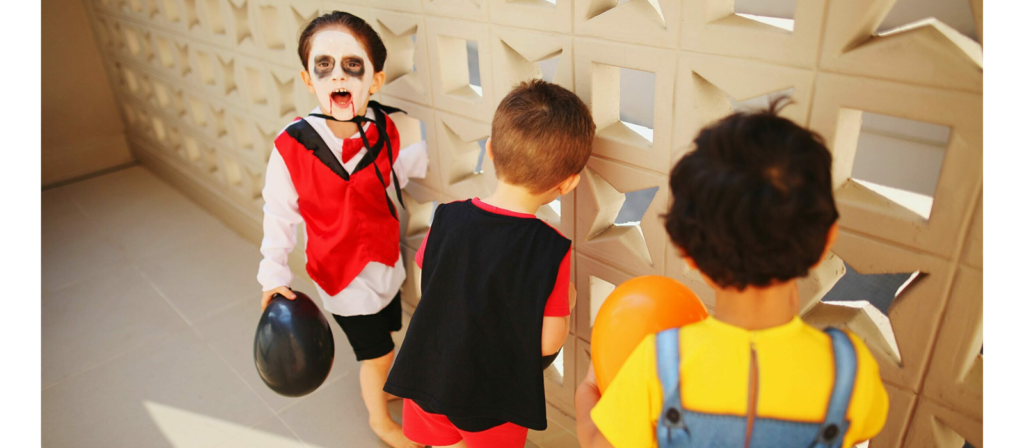
Helping Adults Understand Children Better
One of the hidden strengths of dramatic play is that it reveals how children see the world. Their stories, characters, and dialogue give teachers and caregivers insight into their thoughts and feelings. Listening to play scenarios can help identify emotional needs, misunderstandings, or developmental concerns that might otherwise go unnoticed.
How to Set Up a Dramatic Play Area
Creating a well-organized dramatic play area is one of the most effective ways to support preschoolers’ imagination, independence, and social-emotional growth. Whether you’re starting small or designing a fully themed dramatic play center, the way you prepare the space can significantly enhance children’s engagement and learning outcomes.
Start with a Defined, Safe Space
First, choose a quiet and clearly defined corner of the classroom. Children feel more focused and secure in spaces that have physical boundaries, like rugs, shelves, or partitions. These boundaries help signal that this is a special area meant for play, while also minimizing distractions from other activities happening nearby.
Use Child-Sized Furniture and Open Layouts
Furnish the space with child-sized tables, chairs, and storage units. Realistic proportions allow children to move comfortably and independently, mimicking real-life roles more naturally. Tables can become restaurant counters, classroom desks, or kitchen prep stations, depending on the weekly dramatic play theme.
Organize Props to Support Independent Play
Keep all materials visible and accessible. Use open bins, labeled containers, or cubbies for storing costumes, tools, pretend food, and other props. When children can find and return materials on their own, they learn responsibility and gain confidence—two key goals in early childhood education.
Combine Real and Pretend Materials
A powerful, dramatic play area doesn’t require expensive equipment. Everyday items like old telephones, calculators, metal pots, or even cardboard boxes can stimulate rich pretend play. When real objects are combined with child-friendly pretend props (like plastic food or fabric costumes), the result is a more immersive and believable play environment.
Rotate Themes to Keep Engagement High
Switching dramatic play ideas weekly or monthly helps maintain children’s interest. One week, your setup could be a veterinary clinic; the next, a fire station or post office. Even simple changes—like swapping a kitchen into a bakery by adding trays and menus—can re-energize a familiar space.
Offer Visual and Verbal Prompts
For children who may hesitate to jump into imaginative play, offer role cards, signboards, or visual cues. These might say “Chef,” “Customer,” or “Doctor,” and help children understand the scenario while supporting early reading and social understanding.
The Educator’s Role in Sociodramatic Play
In any well-designed dramatic play center, the educator plays a key role—not always in leading, but often in observing, guiding, or enriching the experience. The level of involvement depends on the learning goals and how children engage with the scenario.
Educators may take on roles such as:
- Onlooker – Watching and encouraging with gestures or words, giving children full ownership of the play.
- Stage Manager – Setting the stage: organizing materials, creating props, and offering scene suggestions to support new dramatic play ideas.
- Co-Player – Joining the play as a character, guiding conversation, or helping resolve role conflicts.
- Play Leader – Introducing problems to solve, modeling collaboration, and deepening the storyline.
This flexible approach aligns with integrated teaching strategies seen in many early learning frameworks. In preschool environments, this means blending child-directed play with guided interaction, especially during complex sociodramatic play like “restaurant,” “hospital,” or “travel agency” scenes.
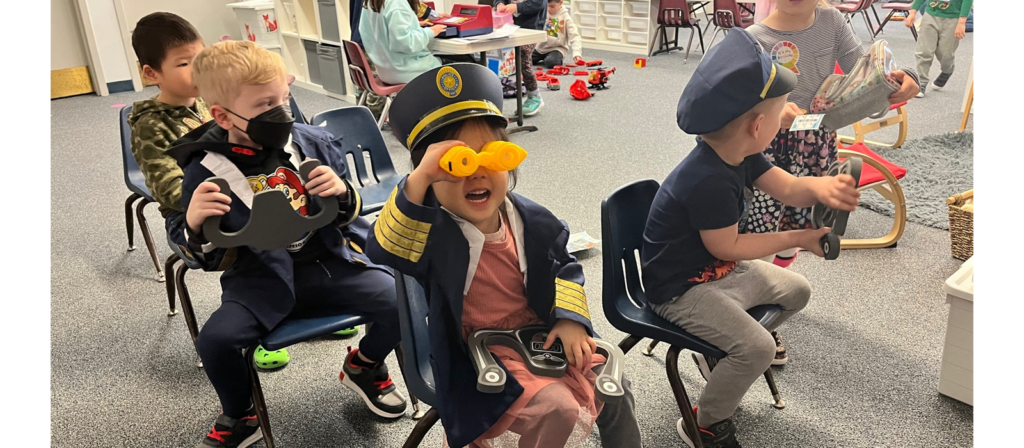
Embedding Language in Dramatic Play
Dramatic play offers rich opportunities to build vocabulary, conversation skills, and storytelling abilities—all through playful interaction.
When designing dramatic play ideas for preschool, consider:
- Language-rich environments: Label props, use signs, and provide costumes that prompt specific vocabulary (e.g., doctor, passport, checkout, spaceship).
- Concept building: Highlight action words, describing words, and prepositions as children move through different scenarios like a beach, zoo, or magic shop.
- Modeling dialogue: As a co-player, help children learn to ask questions, negotiate roles, and explain actions.
- Story creation: Encourage children to invent new places, characters, and outcomes—like flying boats or magical gardens. These imaginative moments bring dramatic play ideas to life and build higher-order thinking.
A well-equipped classroom, supported by thoughtful adult interaction and adaptable preschool furniture, allows children to immerse themselves in pretend play fully. With the proper setup and guidance, dramatic play becomes a bridge between learning, language, and creativity, ready to adapt to every classroom’s unique needs.
Conclusión
Dramatic play is far more than a fun classroom activity—it is a dynamic, multi-sensory experience that shapes the way young children think, feel, and connect with the world around them. Throughout this guide, we’ve explored over 70 dramatic play ideas for preschool, from themed roleplay centers to seasonal setups and identity-based scenes. Whether it’s a pretend bakery, a post office, or a science lab, these experiences nurture language, empathy, creativity, and problem-solving skills in ways that few other activities can.
But the magic of dramatic play doesn’t happen on its own—it relies on environments that invite children to explore freely and safely. The right space, furniture, and layout can make or break a child’s ability to fully engage. That’s why having high-quality, child-centered furniture matters. At TOP Montessoris, we specialize in manufacturing functional, durable, and affordable preschool furniture that supports exactly these kinds of immersive play experiences. Our designs are built not only for comfort and safety but also to encourage the kind of imaginative exploration that makes dramatic play meaningful in every early learning environment.
FAQs: Dramatic Play Ideas
How to Do Dramatic Play in Small Spaces?
You don’t need a full dramatic play center to bring imagination to life. Many dramatic play ideas work just as well in small areas—even in classrooms with limited space or at-home learning environments.
Focus on offering lightweight, versatile props that invite creativity without needing permanent furniture or bulky setups. These items are perfect for flexible play:
- Masks and capes
- Halloween costumes or simple dress-up pieces
- Tea sets, pretend dishes, or food
- Dolls and stuffed animals
- Hats, badges, and belts
- Fairy wings or butterfly wings
- Play jewelry
- Writing supplies like notebooks, pens, or clipboards
- Picture books for reenacting stories
With just a few of these on hand, educators can still create meaningful and engaging dramatic play experiences for preschoolers or toddlers—no ample space required.

